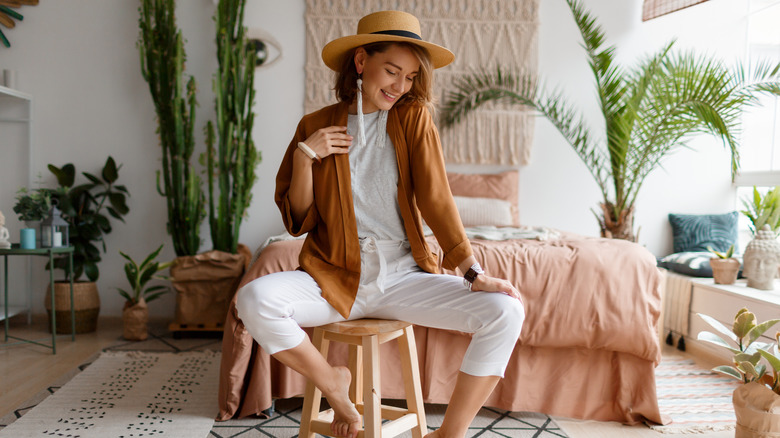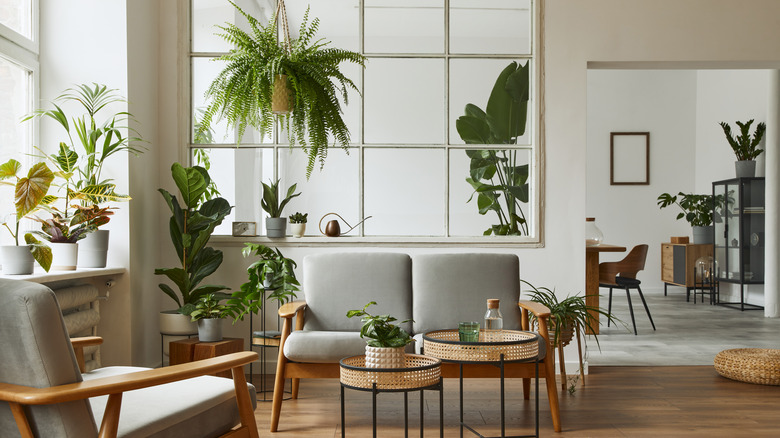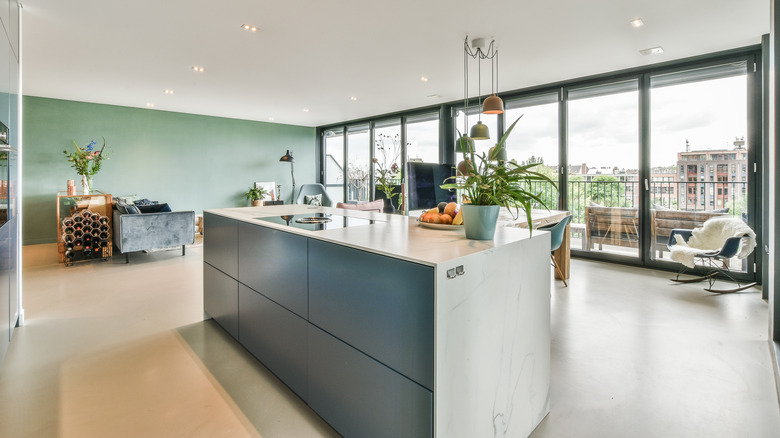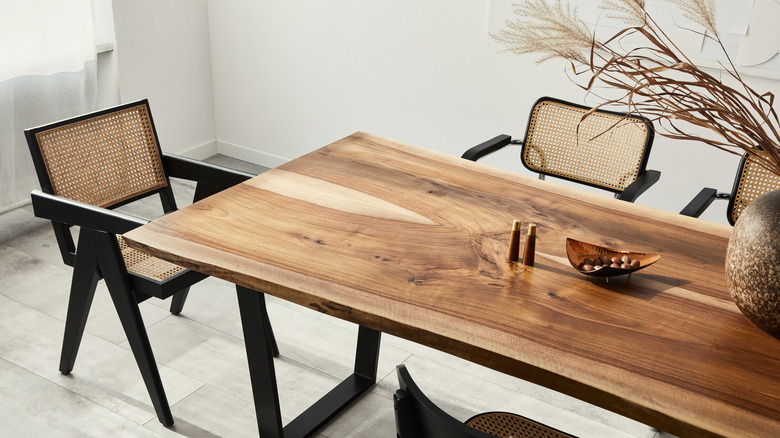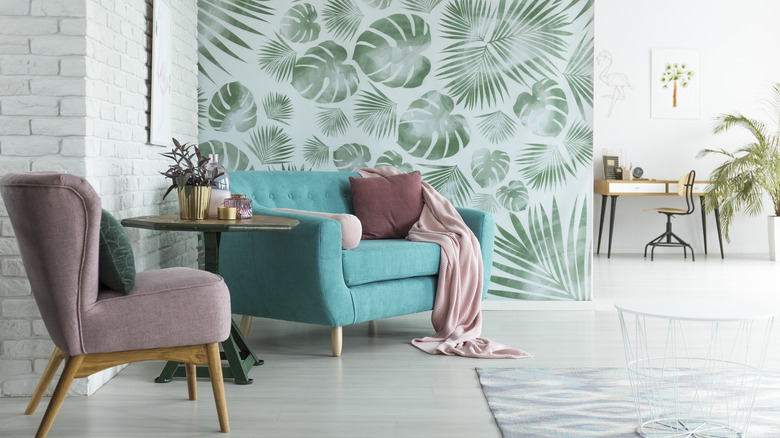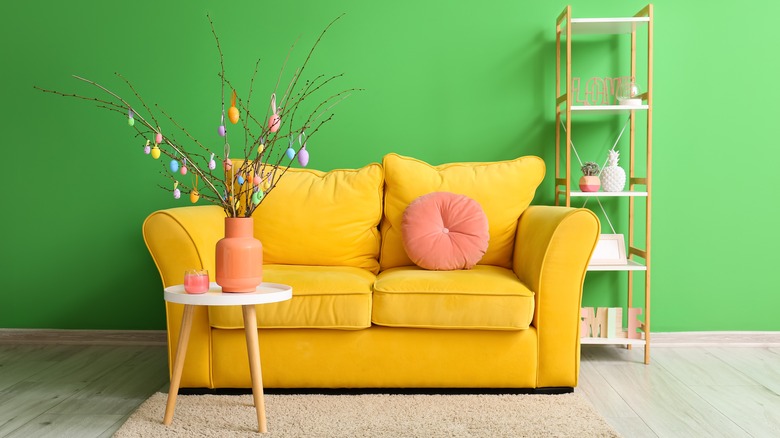How To Bring Biophilic Design Into Your Home, According To An Expert
If you're looking to add a bit of life to the inside of your home, then adopting a biophilic design ethic might be just what you need. The name may bring to mind tumultuous memories of grade school science classes, but don't fear. Originally coined by German psychologist and author of "The Anatomy of Human Destructiveness," Erich Fromm, biophilia is simply a fancy term that characterizes humankind's love of the living world, according to Master Class. Fromm brought forth the ideology that humans experience a healthier way of life when they remain in touch with the natural environment. When taking this ethos in the direction of interior decorating, the incorporation of biophilic design concepts means bringing those true-to-life components indoors. It allows you to introduce live elements found in the world around you and infuse them into your living space.
The biophilic design aesthetic is ideal for those who are in tune with nature and already have a funky bohemian style working for them, or those that are looking to soften up their current décor. Whether you're new to this concept or have fully embraced it with open arms, it helps to have expert advice guiding you through the process. In an exclusive House Digest interview, interior designer, owner, and president of Shades of Gray Design Studio, Melissa Fields, tells us the best ways to bring biophilic design into the home.
Add live greenery to your space
According to expert interior designer Melissa Fields, your first steps toward executing this green-friendly design concept can be incredibly easy. "Biophilic design is all about the connection of humanity with nature, so you can bring live plants or even a living wall into the overall design of your home." By decorating with indoor plants you add unique layers around the home and now have living, breathing elements that interact with you and anyone else who enters the environment. Depending on how busy you are, you may want to choose plant life whose care requirements best fit your life schedule. If you're constantly on the go, for example, lean toward low-maintenance species such as succulents, cacti, aloe, monstera, and even rubber plants, suggests HGTV.
Otherwise, if you're already an avid gardener and self-certified green thumb, let your imagination run wild and choose fun and flowery plants to mingle with your sense of design. For a more vivacious look, you could dedicate a small area to creating an indoor vertical garden. "A living wall requires water to sustain it, so that is another way to bring nature inside: the presence and sound of water," Fields explains. "This can also be achieved with fountains or mini-ponds." By carefully hanging vertical planters on a wall space with some simple irrigation techniques, you can create a lovely naturalistic focal point.
Bring in natural light
Of course, all those live plants peppered around your home require an energy source to keep them growing healthy and strong. "Let the light shine — natural light that is," expert Melissa Fields says. "It's bringing those natural elements into your space that connects you to the outdoors." Allowing sunlight to pour into your home is beneficial in many ways. For example, if you have a home office, positioning your work station near a big window helps make visibility better while also boosting your mood, according to Healthline. "If you have heavy window coverings on your windows, consider removing them and opt for no coverings or sheer coverings — especially if you have a backyard that provides a great nature backdrop such as a mountainous range or lots of trees," Fields suggests.
Staying away from artificial light as a source of illumination during the day and making more natural light available to the inside of your home will ensure that your environment looks warmer and more inviting. Sunlight also supplies energy-boosting vitamin D, which can be much appreciated throughout the year. As for design elements utilizing daylight, Fields points out that large picture windows are the best for highlighting outdoor panoramas because of their ability to frame a view like artwork. "Skylights are... another great option to flood your home with more natural light," she further mentions.
Incorporate furniture made out of natural materials
When leaning into the biophilic design aesthetic it helps to step back and take inventory of the existing furniture in your space. If you find that your current chairs are manufactured items with cold metallic accents or that the surfaces of your tables are veneered with laminate wood, then it could be time to branch out to new possibilities. "Using materials such as stone, wood, or leather in furnishings and building materials (for kitchen or bath remodels) is a fantastic way to bring nature into your home," interior designer Melissa Fields tells us. "They tend to last longer and will patina or age gracefully over time." To discover more sustainable options that are sure to bring a unique flair to your eco-friendly décor, try scouring for vintage items at your local antique market. Some of these classic pieces will be works of wood-carved artistry, and you'll be saving them from winding up in landfills.
Fields further suggests organic materials such as jute and sisal area rugs and rattan or cane furniture to accentuate the natural vibe. Even your kitchen counters can be made more in line with elements that reflect nature. If stone, marble, and granite are too harsh for your liking, perhaps make the change to a large wooden butcher block countertop that would better suit your taste.
Mimic natural patterns or forms found in nature
Another way to infuse some biophilic design into your home is to take ideas from what Mother Nature has to offer. Floral patterns can be found in just about any shape, color, or plant species imaginable. Search for something that matches your décor and choose a bright plant-patterned throw pillow or area rug. "Look at what you see outside in the forest, at the beach, or in the mountains, and bring those shapes and elements indoors," expert Melissa Fields suggests. "Create an accent wall or niche that mimics the curve of a wave, select artwork that mimics the curves of rolling hills, or use a circular-shaped light fixture."
Luckily, there are plenty of options available when it comes to outdoor-inspired patterns and prints that you can find in a wide variety of fabrics and knickknacks. "For décor, you can use irregular shaped vases inspired by natural organisms or display images of nature and its forms through murals or textured wallpaper," says Fields. To focus your attention so as not be overwhelmed with ideas, sit down and make a plan. Take your time and survey the room you're looking to decorate. Do you want to mirror the current plant life already in the space or would you prefer to start fresh with a new nature-enlightened theme?
Decorate with nature's colors
Tired of the same old white walls? Screaming to get rid of that drab greige from your house? Maybe it's time to let nature's tones take over. "Don't be afraid to go bold!" emphasizes Melissa Fields. "Natural colors are not just the browns, tans, and earth tone colors we all immediately think of. They can also be deep, moody colors like the green you see in trees, grass, and plants. Or a rich blue like you see in the ocean, a lake, or a beautiful wildflower." When deciding which nature-inspired hues to bring into your home, consider the feel you want each room to invoke. For an engaging and inviting living room, you may want to maximize the use of warm colors such as orange, yellow, or red. However, if you want to create a relaxing vibe, then cool tones like lavender, blue, and green will help balance the energy.
Fields ensures that incorporating biophilic design elements doesn't have to be a large-scale affair. Instead, you can start small or choose a different path to introduce the same biophilic style results. "If you're hesitant about repainting an entire room, you can start with just one accent wall," she says. For those who find the idea of taking on a new painting challenge to be daunting, Fields adds, "You can bring these colors in through different textures, tones, and shades in fabric, accessories, and artwork."
